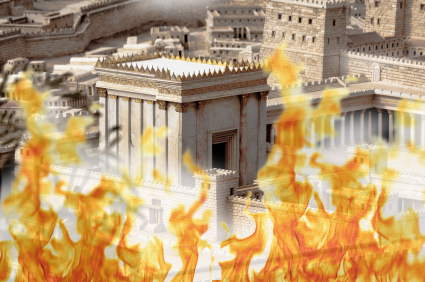
At the beginning of Parshas Devarim (1:12), the words “Eicha esa l’vadi… How can I alone…” signal the impending fast, mourning and reading of Megillas Eicha on Tishah B’Av marking the destruction of the two Temples in Yerushalayim. Yet, it is a struggle to understand the enormity of their loss.
At the rebuilding of the Second Temple, there were intense and contrasting emotions. Those people who had never seen the glory of the First Temple were joyous to witness the rebuilding of the Second Temple, despite its diminished stature. At the same time, older people who had witnessed the grandeur of the First Temple wept with the same intensity, since they were focusing on what had been lost. (See Ezra 3:11-13).
What was missing from the First Temple? The Divine Presence of God (Shechinah), prophecy, and open miracles. The magnitude of this loss did not prevent those rebuilding the Second Temple from rejoicing, in full sight of those who were weeping! All the more so today, it is difficult for us who have never witnessed the grandeur of the Temple, and all that accompanied it, to really feel like our lives are incomplete without it.
Rabbi Chaim Friedlander writes in Sifsei Chaim (Vol. III, p. 284):
“We mourn for the destruction of the two Temples, even though it is difficult for us to cry and to understand the implications of their loss. Just the opposite is true, we feel satisfied, even with all the suffering surrounding us, as if we are not lacking anything physical or spiritual at all. This feeling prevents us from being able to properly mourn the destruction, as we cannot feel nor sense what, in essence, we are missing. Therefore, it is incumbent upon us to learn and understand the deep consequences of the destruction and to feel and understand how our situation has declined from the time of the destruction until now.”
Rabbi Yehoshua Hartman, the head of the Hasmonean Beis Hamedrash, delivered an important Tishah B’Av address last year in London (Harnessing the Churban for Binyan). To sharpen feeling the loss of the Temples, Rabbi Hartman cited the gemara in Bava Basra 21a explaining why Yehoshua ben Gamla instituted that everyone send their children to be educated in Yerushalayim. Why in Yerushalayim? Based on the verse, “From Tzion Torah will go forth” (Yeshayahu 2:3). Tosofos explains that anyone coming to Yerushalayim experienced great holiness upon seeing the Kohanim engaged in the avodah at the Beis HaMikdosh. This would inspire the school children and their teachers to reach greater heights of yiras Shamayim and Torah study.
Rabbi Hartman also shared the writings of Rabbi Aharon Kotler from Mishnas D’Rebbi Aharon: “It is known that someone who witnessed the Vilna Gaon learning Torah or davening would be inspired for many years afterwards! This is the impact of a human being who is called a ‘Mikdosh Me’at.’ How much more so had we seen the Beis HaMikdosh itself!”
Rabbi Hartman concluded, “We are therefore missing something that would have given us a tremendous chizuk in yiras Shamayim and Torah. Can you imagine Yiddishkeit without Shabbos? Yiddishkeit without Tefillin? It’s impossible and yet that’s what we’re missing without the Beis HaMikdosh!”
It is inconceivable to live as a Jew today without Shabbos. Yet, such is the comparable loss to our avodas Hashem without the Beis HaMikdosh!
One who understands the loss of the Temple will be motivated to embark on its rebuilding. As the gemara relates in Taanis 30b, “Whoever mourns for Jerusalem will merit sharing in her joy [when the Temple will be rebuilt.]”
There are two NLE Morasha shiurim addressing the Three Weeks and Tishah B’Av:
The Three Weeks and Tishah B’Av I: Exile & Destruction
The Three Weeks and Tishah B’Av II: Why the Temple was Destroyed & How to Rebuild It



















